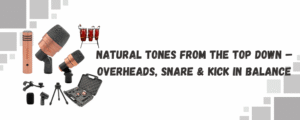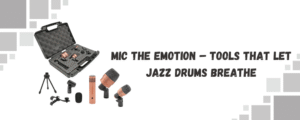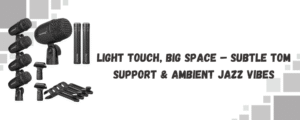Jazz drumming is all about feel. It’s subtle, expressive, and often less about power and more about touch. But capturing that in a recording or on stage? That’s where it gets tricky.
You’re not chasing punchy rock tones or electronic tightness. You’re chasing warmth. Air. Space. The brushes on the snare, the resonance of an open ride, the breath behind the beat. And that kind of jazz drum sound doesn’t come from just throwing a mic on each drum—it comes from thoughtful mic placement and gear that respects dynamics.
Let’s break down how to mic a jazz kit properly—whether you’re recording in a treated room or trying to recreate that club vibe on stage.
Start with the Overheads – That’s Your Core
In jazz, the overheads aren’t just cymbal mics. They are the kit. Your snare, your toms, even some kick tone—it all bleeds in. So if you get nothing else right, get this right.
Use a pair of small diaphragm condenser mics. Space them wide enough to capture the stereo image, but close enough to avoid phase issues. An XY or ORTF configuration just above the drummer’s head usually does the trick. Think of it like you’re placing a pair of ears right where the audience would be—slightly above, centered, and neutral.
The 5 Core condenser instrument mic is built for this kind of job. It’s crisp without being harsh and sensitive enough to catch brush strokes, ghost notes, and cymbal swells without adding artificial brightness. That matters. You want tone, not hype.
Kick Drum – Keep It Natural
Forget the scooped mids and sub-bass thump. Jazz kick drums aren’t supposed to shake the floor—they’re supposed to sit in the mix. They’re felt more than heard. And they usually don’t have port holes, which means you’re not sticking a mic inside.
Use a dynamic or a large diaphragm condenser just outside the resonant head, about 6–8 inches back. Angle it slightly off-center to reduce boom and focus on the beater tone. The goal is to get that soft, pillowy thud with a touch of low-mid warmth. Nothing clicky. Nothing scooped.
And if you’re on stage, where bleed is unavoidable? A compact dynamic mic with controlled off-axis rejection, like the Shure Beta 52A is your ally. It won’t color the sound too much, and it’s tough enough to take stage noise without folding.
Snare – Let It Breathe
Jazz snare tones are wide open. You’re not choking them with gates or burying them in effects. So mic like it.
A small diaphragm condenser or a mellow dynamic mic works best here. Skip the aggressive presence boost you’d use for rock—go for something flatter and more honest. Place it a few inches above the rim, angled toward the center of the head, but not too steep. You want stick definition, brush texture, and some shell resonance.
Don’t be afraid of bleed. You’re not trying to isolate every sound—you’re trying to capture the conversation between the drums.
If you’re already using good overheads and you’re pressed for channels, you can even skip the snare mic. But if your overheads are riding too high or if the room is lively, a dedicated snare mic will anchor the groove better.
Tom Miking – Less is Usually More
Unless the arrangement demands it, you don’t always need to mic jazz toms individually. The overheads usually catch enough of them, especially if your player isn’t bashing. But if you do want extra definition, a slim condenser like the 5 Core jazz instrument mic is a clean, compact way to do it.
Mount it low and aim across the head at a shallow angle. Keep it out of the stick’s path, but close enough to pick up attack. You’re not going for power—you’re going for warmth and shape.
Hi-Hats – If You Must
A lot of jazz players skip hi-hat mics entirely. And honestly, if your overheads are dialed in, you probably don’t need one. But if the hats are super active—think comping in a trio or crisp 16th notes on a ballad—then you might want a dedicated mic.
Use a small diaphragm condenser placed 5–6 inches above the edge, pointed slightly off-axis. You want shimmer, not sizzle. Too much top-end, and it’ll take over the whole mix. The trick is to blend it behind the overheads, not on top of them.
Room Mics – The Jazz Secret Weapon
If you’re recording in a good-sounding room, don’t waste it. A single room mic, placed about 6–8 feet in front of the kit at waist height, can bring depth and cohesion to your mix. Ribbon mics are ideal here, but a warm condenser will do fine.
Pan your overheads for stereo image, then blend in the room mic dead center. It glues everything together without needing tons of reverb. You’ll get ambiance, natural decay, and that “live” feel jazz thrives on.
Final Thoughts
Capturing a jazz drum sound is less about control and more about respect. Respect for the room, the gear, and the subtlety of the playing. You’re not building a wall of sound—you’re leaving space for everything to breathe.
That’s why mic choice matters. Mics like the 5 Core condenser instrument mic aren’t just about specs—they’re about transparency. They get out of the way and let the drums speak.
Because in jazz, what isn’t played is just as important as what is. Your mics should know that too.




